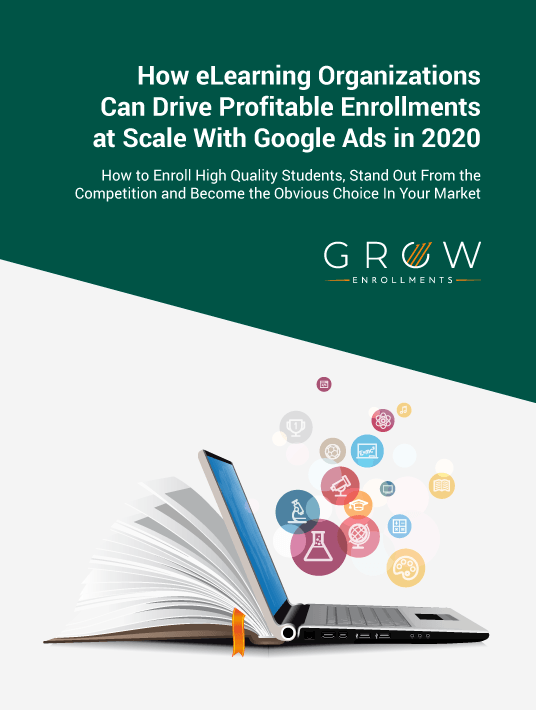A Quest That Never Ends
The quest to discover the best practices for automation and integration of ads is never-ending. Over the past 2-3 years, Google has significantly improved their own automated bidding solutions, which are available for no additional fee within the Google Ads platform. Google automation is the only way to perform auction time bidding optimizations, which can be extremely advantageous. With millions of data signals going into every auction, the bidding is optimized for each prospective student in accordance with the account’s goals.

Automation used to be a way to alleviate the pressure of manual bidding, while occasionally introducing another layer of data. Now, automation is driving massive improvements in performance and leaving manual-based strategies in the dust.
What Are The Best Practices For Automation?
Before implementing smart bidding, here are a few important tips we recommend:
- Audit conversion actions
It’s crucial to fix any conversion tracking issues to ensure that conversion data is being reported properly. Then, you have to confirm that the right conversion actions are included in the "Conversions" column in Google Ads. In your account, go to Measurement > Conversions. Check the "Include" in the “Conversions” column and see if the right conversions have the value as “Yes.” - Add first-party audience lists to campaigns (Customer Match, RLSA, Similar Audiences)
These are lists of prospective students identified by first-party data. They will provide Smart Bidding with more data so it can make better decisions on when to bid up or down on auctions. - Implement a non-last-click attribution model
Non-last-click models help you understand the exact value of each interaction with your Google Ads. Smart Bidding automatically assesses these touchpoints and prioritizes those that are most impactful. We recommend using a data-driven attribution model if you meet the requirements for eligibility. - Give the AI some room
When implementing TCPA or other automated bidding strategies, it is tempting to tell the algorithm to hit some really low CPA and expect immediate results. But if you were getting a $150 CPA on manual, it is best to set a similar goal when implementing automated bidding and then gradually work it down. It might also take a few days for the algorithm to adjust to significant optimizations.
When To Implement Google Ads AI
As I’m writing this in March 2020, one of the best practices for automation is launching campaigns on manual CPCs for the first 30 days before shifting gears into eCPC for an additional 30 days.
Afterward, I would start integrating TCPA into your lead generation campaigns after a substantial amount of data has been accumulated.
You want to get your campaigns to a point where there is enough data to create low or very low CPA fluctuation along with a fast or very fast initial learning period. At that point, you should be very confident that the campaign has enough data to switch from manual to AI.
Different Google Ads AI Options
Portfolio Smart Bidding
This is a goal-driven strategy that groups together multiple campaigns, ad groups, and keywords. It can be very effective if you have multiple campaigns for the same programs that share the same goals. For example, if we were promoting a class for cybersecurity and you have several campaigns broken out by match types, we would want to group all the campaigns together into one portfolio bidding strategy. This way, the strategy aims to hit one goal across all of the campaigns.
Campaign Smart Bidding
This is the process of creating a TCPA goal on a campaign-by-campaign basis. Campaign Smart Bidding is particularly useful when you’ve consolidated devices and match types into one campaign for the same program or goal.
Ad Group Smart Bidding
Once you’ve activated campaign TCPA, you can start changing TCPA goals by ad groups. I would not recommend using this strategy. If you’re using Ad Group Smart Bidding, it’s probably because your campaign structure is not organized properly.
Final Tips
The more data you consolidate for Google to analyze, the more success you will have with automation. That’s why I am a strong believer in portfolio bidding. You can have granular campaigns/ad group structure, but still consolidate all the respective campaigns into portfolio bidding strategies so they can learn from each other and make decisions that are simply not possible with manual. If you’re not using automation today, you’re leaving a significant amount of opportunity on the table. Manual bidding doesn’t come close to what the best practices for automation can do.
When Not To Use Automation
- Stability issues and bugs
Google regularly updates this part of their software. When bugs are discovered, the advertisers eat up the cost. It’s safe to assume there will always be bugs but don’t expect Google to disclose this because there is no way for us to prove it—or sometimes even notice it. - Control
Allowing AI to handle most of our tasks as marketers sacrifices a great deal of control over the account. For example, if we want to increase or decrease spend, we’re not able to do this as quickly under an AI bidding strategy compared to manual bidding. - Branded campaigns
AI can overpay for branded keywords if we’re not careful. Since most branded keywords have a quality score of 10/10 and there shouldn’t be much reason to regularly change bids for these keywords, we should stick to manual.
Increase Enrollments For Your Organization
Is increasing enrollment important to you and your organization? Are you looking for ways to increase digital engagement? If yes, make sure to read How eLearning Organizations Can Drive Profitable Enrollments At Scale With Google Ads In 2020 and harness the amazing power of Google Ads to help enrollment grow.

